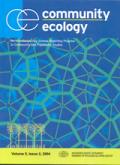New article: Woodland bird response to landscape connectivity in an agriculture-dominated landscape

 In a new study published in the journal Community Ecology, Assu Gil-Tena and co-workers have assessed the role of landscape connectivity in woodland bird species richness, abundance, and community similarity in north-east Brittany (north-west France). Over the last 30 years, ecological networks have been deployed to reduce global biodiversity loss by enhancing landscape connectivity. Bird species dwelling in woodland habitats that are embedded in agriculture-dominated landscapes are expected to be particularly sensitive to the loss of connectivity. In this study, an exhaustive woodland selection protocol was carried out to minimize the effects of woodland size on the response variables. Connectivity of the woodland and forest network in the study area was evaluated using graph-theory, accounting for matrix permeability, and a characteristic median natal dispersal distance at the community level based on the bird species pool recorded in the sampled woodlands. Information-theoretic model selection, controlling for woodland size in all the cases, depicted the response of woodland birds at the community level to the connectivity of agriculture-dominated landscapes. On average, the sampled woodlands (n = 25) contained 15.5 ± 2.4 bird species, with an abundance of 25.1 ± 3.9, and had highly similar bird communities (species composition and proportion); eight species represented 57% of total abundance and were present in at least 22 woodlands. The performance of models improved when using effective, rather than Euclidean, interpatch distances in the connectivity assessment. Landscape connectivity was only significantly related to similarity of proportional species composition. Large woodlands contained communities with more similar species proportions in an inhospitable agricultural landscape matrix than in a more permeable one. Woodland size was the most relevant factor determining species abundance, indicating that the bird population sizes are primarily proportional to the local habitat availability. Connectivity in relation to landscape matrix permeability did not seem to induce the flow of woodland-dependent bird species that are dominant in the community but rather of matrix-dwelling bird species that are less dependent on woodland patch area. In conclusion, both habitat conservation and restoration (i.e., amount and quality), in combination with permeable landscape structures (such as heterogeneous land cover mosaics), are advocated for community level conservation strategies.
In a new study published in the journal Community Ecology, Assu Gil-Tena and co-workers have assessed the role of landscape connectivity in woodland bird species richness, abundance, and community similarity in north-east Brittany (north-west France). Over the last 30 years, ecological networks have been deployed to reduce global biodiversity loss by enhancing landscape connectivity. Bird species dwelling in woodland habitats that are embedded in agriculture-dominated landscapes are expected to be particularly sensitive to the loss of connectivity. In this study, an exhaustive woodland selection protocol was carried out to minimize the effects of woodland size on the response variables. Connectivity of the woodland and forest network in the study area was evaluated using graph-theory, accounting for matrix permeability, and a characteristic median natal dispersal distance at the community level based on the bird species pool recorded in the sampled woodlands. Information-theoretic model selection, controlling for woodland size in all the cases, depicted the response of woodland birds at the community level to the connectivity of agriculture-dominated landscapes. On average, the sampled woodlands (n = 25) contained 15.5 ± 2.4 bird species, with an abundance of 25.1 ± 3.9, and had highly similar bird communities (species composition and proportion); eight species represented 57% of total abundance and were present in at least 22 woodlands. The performance of models improved when using effective, rather than Euclidean, interpatch distances in the connectivity assessment. Landscape connectivity was only significantly related to similarity of proportional species composition. Large woodlands contained communities with more similar species proportions in an inhospitable agricultural landscape matrix than in a more permeable one. Woodland size was the most relevant factor determining species abundance, indicating that the bird population sizes are primarily proportional to the local habitat availability. Connectivity in relation to landscape matrix permeability did not seem to induce the flow of woodland-dependent bird species that are dominant in the community but rather of matrix-dwelling bird species that are less dependent on woodland patch area. In conclusion, both habitat conservation and restoration (i.e., amount and quality), in combination with permeable landscape structures (such as heterogeneous land cover mosaics), are advocated for community level conservation strategies.




